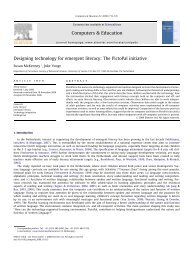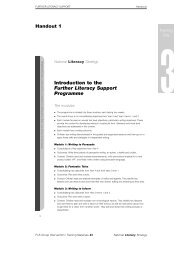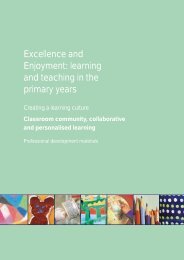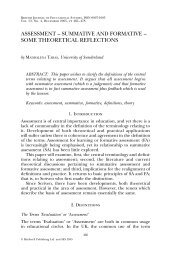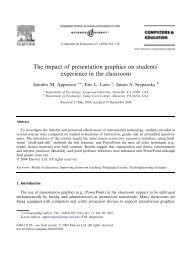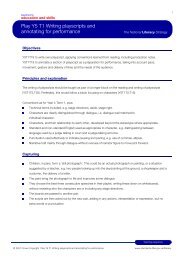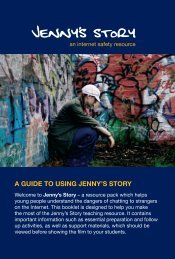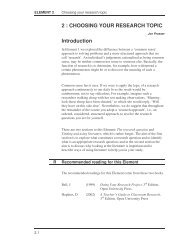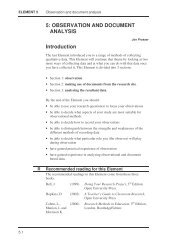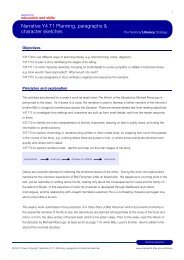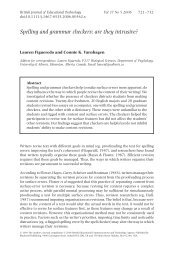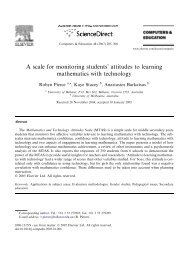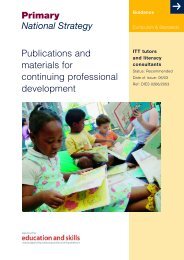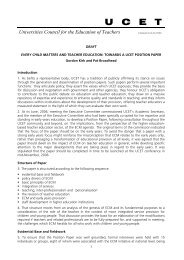Mathematics and Inclusion Mathematics and Inclusion - PGCE
Mathematics and Inclusion Mathematics and Inclusion - PGCE
Mathematics and Inclusion Mathematics and Inclusion - PGCE
Create successful ePaper yourself
Turn your PDF publications into a flip-book with our unique Google optimized e-Paper software.
DfES 0606-2003Primary National StrategyContentsIntroduction 5Section 1: Observing three key groups 7Section 2: Planning inclusive teaching <strong>and</strong> learning in mathematics 19Section 3: Assessment approaches 34Appendix iITT examples of inclusion provision within course programmes 40Appendix iiVideo notes <strong>and</strong> suggested activities 44Appendix iiiDefinitions of inclusion 46Appendix ivResearch articles 49Appendix vBibliography 113Appendix viNational Numeracy Strategy inclusion resources 117<strong>Mathematics</strong> <strong>and</strong> <strong>Inclusion</strong>Materials for providers of Initial Teacher Training© Crown copyright 20033
Primary National Strategy DfES 0606-2003AcknowledgementsPatti Barber Institute of Education, University of LondonMarion Gatrell University of PlymouthCathy Hamilton Bath Spa University CollegeHelen Mulholl<strong>and</strong> University of the West of Engl<strong>and</strong>Jean Murray Brunel UniversityChristine O’Mahony Disability, Equality in EducationReg Wrathmell King Alfred’s College, WinchesterThe following publications, which appear in appendix iv, pages 49–112, are reproduced bypermission of the copyright holders.Page 50, Corbett, Jenny, Teaching approaches which support inclusive education: aconnective pedagogy, British Journal of Special Education, Volume 28, No. 2 (June 2001),pages 55–59. Richard Byers, ed. © Blackwell Publishing.Page 55, Eyre, D. <strong>and</strong> McClure, L., chapter 3, <strong>Mathematics</strong>, pp.64–89, in CurriculumProvision for the Gifted <strong>and</strong> Talented in the Primary School: English, <strong>Mathematics</strong>, Science<strong>and</strong> ICT. Published by NASEN/David Fulton Publishing Ltd, 2001. © D. Eyre, L. McClure.Page 81, Raiker, A., Spoken language mathematics, Cambridge Journal of SpecialEducation, Volume 32, No. 1, pp. 45–60. © Andrea Raiker.Page 110. Visser, John, Opening address at the ATM 2002 Easter conference. This materialwas subsequently published in the Easter Conference Supplement, <strong>Mathematics</strong> Teaching,No. 179, June 2002 (a journal of the Association of Teachers of <strong>Mathematics</strong>). © JohnVisser.Copnor Junior School, PortsmouthHoly Family RC Primary School, SouthamptonLittletown Primary, HonitonLympstone Church of Engl<strong>and</strong> Primary School, LympstonePlymouth University, Faculty of Arts <strong>and</strong> EducationPortsmouth Primary SCITTPrimary Catholic Partnership SCITTStokehill First School, ExeterTidcombe Primary, Tiverton4© Crown copyright 2003<strong>Mathematics</strong> <strong>and</strong> <strong>Inclusion</strong>Materials for providers of Initial Teacher Training
DfES 0606-2003Primary National StrategyIntroductionPurpose of the materialsThese inclusion materials consist of a file <strong>and</strong> an accompanying video. They are intended toprovide a variety of resources, information <strong>and</strong> ideas to support tutors in:• helping trainees to consider the needs of all pupils when planning <strong>and</strong> assessingmathematics;• enabling trainees to make connections between recent <strong>and</strong> relevant research related toinclusion <strong>and</strong> the pupils’ learning experiences;• engaging trainees in debate <strong>and</strong> evaluation of their own practice with respect to inclusionissues in mathematics.The materials are designed to complement existing resources within course programmes.Key principlesThe definition of inclusion initiates much debate <strong>and</strong> discussion. Trainees may find it helpfulto consider the various definitions of inclusion <strong>and</strong> prioritise these in terms of their ownbeliefs <strong>and</strong> experiences. The activities in appendix iii on pages 46–48 may prove a usefulstarting point for this process.The materials reflect Wave 1 <strong>and</strong> Wave 2 of the National Literacy Strategy (NLS) <strong>and</strong> theNational Numeracy Strategy (NNS) model of three ‘Waves’ of support, as well as theinclusion references within the Professional St<strong>and</strong>ards for Qualified Teacher Status (DfES,2002). Wave 1 is about what should be on offer for all pupils: the effective inclusion of allpupils in a high-quality daily mathematics lesson. Wave 2 concerns pupils who, supportedby the class teacher <strong>and</strong> other adults, can be expected to ‘catch up’ with their peers as aresult of this intervention. There is an additional Wave 3 level of support involving specifictargeted intervention for pupils identified as requiring SEN support.The information <strong>and</strong> ideas within the materials focus on specific <strong>and</strong> generic principles ofinclusion in relation to mathematics teaching <strong>and</strong> learning. The aspects <strong>and</strong> suggestedactivities within each section exemplify Corbett’s description of exceptionally skilful inclusionpractice where ‘There is a real effort made to involve the learners, to create situations inwhich they can meet with success <strong>and</strong> to build on their existing level of knowledge’(Corbett, 2001). The materials also highlight the principle that all pupils have strengths thatdeserve recognition.RationaleThe materials have been organised in sections to highlight some key principles, aid flexibilityof use <strong>and</strong> support existing practice. Use of labelled sections <strong>and</strong> space for additional notesenable tutors to select, modify <strong>and</strong> exemplify appropriately.Section 1 focuses on helping trainees to observe <strong>and</strong> analyse three different groups: pupilsrequiring additional support with mathematics; pupils learning English as an additionallanguage; <strong>and</strong> more able pupils. Although these three groups do not represent all groupswithin a school or course programme, it is likely trainees will encounter one or more of thesegroups within school placements.<strong>Mathematics</strong> <strong>and</strong> <strong>Inclusion</strong>Materials for providers of Initial Teacher Training© Crown copyright 20035
Primary National Strategy DfES 0606-2003Sections 2 <strong>and</strong> 3 focus on ways in which planning <strong>and</strong> assessment can support inclusiveteaching <strong>and</strong> learning in mathematics.Appendices i to vi provide examples <strong>and</strong> exemplification of inclusion provision within currentInitial Teacher Training course programmes; suggested activities for the accompanyingvideo; definitions of inclusion; research articles; a bibliography <strong>and</strong> National NumeracyStrategy resources.Existing National Numeracy Strategy <strong>and</strong> QCA video sequences have been drawn togetherin the accompanying video <strong>Mathematics</strong> <strong>and</strong> <strong>Inclusion</strong>: materials for providers of InitialTeacher Training. This video highlights some key principles of inclusion within the teaching<strong>and</strong> learning of mathematics. In addition to these video sequences being referencedappropriately throughout the file, there is also a separate section of possible video activities<strong>and</strong> observation tasks. The video has a counter for ease of reference.6© Crown copyright 2003<strong>Mathematics</strong> <strong>and</strong> <strong>Inclusion</strong>Materials for providers of Initial Teacher Training
DfES 0606-2003Primary National StrategySection 1 Observing three key groupsPupils have different learning styles. The grids on the following pages have been structuredto provide a basis for considering the learning needs of particular groups of pupils <strong>and</strong> theteaching strategies that support them. Analysis of this information may be used to informthe planning process. The grids focus on pupils who:• need additional support in mathematics;• are learning English as an additional language;• are more able at mathematics.Some questions within the grid for one particular group of pupils may also be appropriatefor use with other groups of pupils. An example of this may occur where a pupil requiringadditional support may have significant language issues <strong>and</strong> the language focus questionsfrom the grid for pupils learning English as an additional language may also be appropriate.Trainees may find it useful to identify particular questions <strong>and</strong> issues that they wish to raisewith the class teacher, if there is an opportunity, before <strong>and</strong> after the observation.Suggested use of gridsAdditional bullet points have been provided for further ideas to be added.• Use the information collected by trainees as a starting point for considering key planningissues, teaching strategies <strong>and</strong> assessment implications.• Adapt grid/s to provide a specific focus, e.g. on a pupil’s communication skills or the useof resources.• Ask trainees to add further observation focuses in the empty boxes.• Suggest trainees compile their own observation grid.• ..• ..Follow-up activities using information from the grids can be found on pages 17–18.<strong>Mathematics</strong> <strong>and</strong> <strong>Inclusion</strong>Materials for providers of Initial Teacher Training© Crown copyright 20037
DfES 0606-2003 Primary National StrategyObserving pupils requiring additional support with mathematicsIt is useful to observe a pupil within a mathematical activity/in the daily mathematics lesson (DML) <strong>and</strong> if possible one in which additionaladults are working. It is helpful to look at relevant planning before the activity or lesson.Observation/issues linked to pupilNotes Observation/issues linked to teaching<strong>and</strong>/or other adults working with pupilsat different times of the mathematicalactivity/in the DMLIs the pupil listening to the teacher or adult?Degree of attention?What strategies are used to gain <strong>and</strong>maintain the attention of all pupils?Is the pupil listening to other pupils?Degree of attention?How are all pupils encouraged to listen toeach other?Is the pupil participating as required, e.g. byresponding to questions, chanting, watchingvisual aids or demonstrations, usingresources, etc.?How are all pupils encouraged to participate?Can the pupil engage in the mathematicalactivity without further guidance?How is the mathematical activity explained?How is the mathematical activity madeaccessible for all pupils?How are resources used or organised tosupport mathematical learning?How are expectations made explicit to thepupils?Is the pupil fully engaged in themathematical activity?If not, what is he/she doing instead?How are pupils supported or encouraged tostay on task?<strong>Mathematics</strong> <strong>and</strong> <strong>Inclusion</strong>Materials for providers of Initial Teacher Training© Crown copyright 20038
DfES 0606-2003 Primary National StrategyObservation/issues linked to pupilNotes Observation/issues linked to teaching<strong>and</strong>/or other adults working with pupilsat different times of the mathematicalactivity/in the DMLWhen appropriate, is the pupil workingindependently of teachers, additional adults<strong>and</strong> peers?How is independent working encouraged?When appropriate, is the pupil workingcooperatively or collaboratively with peers,e.g. working alongside peers/discussingpossible mathematical solutions/sharingresources <strong>and</strong> ideas?What strategies are used to promote <strong>and</strong>support cooperation or collaborationbetween pupils?When appropriate, does the pupil askhis/her own questions?Provide an example to illustrate this.When appropriate, are there opportunitiesfor pupils to ask questions?Is the pupil using everyday language <strong>and</strong>/ormathematical words/terms to discuss <strong>and</strong>describe his/her work?How is the use of mathematical words <strong>and</strong>terms promoted or developed?Does the pupil appear to underst<strong>and</strong> <strong>and</strong>recognise his/her own achievement(s)during the mathematical activity/DML?How are pupils’ mathematicalachievements celebrated?<strong>Mathematics</strong> <strong>and</strong> <strong>Inclusion</strong>Materials for providers of Initial Teacher Training© Crown copyright 20039
DfES 0606-2003 Primary National StrategyObservation/issues linked to pupilNotes Observation/issues linked to teaching<strong>and</strong>/or other adults working with pupilsat different times of the mathematicalactivity/in the DMLIs there evidence of the pupil engaging withthe mathematics <strong>and</strong> making progress inmathematics, e.g. identifying patterns,making connections?What strategies are used to enable pupilsto engage with the mathematics?Does the pupil seek help? From whom?How are additional adults or peers used tosupport learning during the mathematicalactivity?<strong>Mathematics</strong> <strong>and</strong> <strong>Inclusion</strong>Materials for providers of Initial Teacher Training© Crown copyright 200310
DfES 0606-2003 Primary National StrategyObserving pupils for whom English is an additional languageIt is useful to observe a pupil within a mathematical activity/in the daily mathematics lesson (DML) <strong>and</strong> if possible one in which additionaladults are working. It is helpful to look at relevant planning before the activity or lesson.Observation/issues linked to pupilNotes Observation/issues linked to teaching<strong>and</strong>/or other adults working with pupilsat different times of the mathematicalactivity/in the DMLHow does the pupil communicate whencarrying out a mathematicalactivity/during the DML?Does he/she respond using resources,pictures, words, sentences, etc.?How does the teaching support pupils’communication skills when carrying out amathematical activity/in the DML?Does the pupil have opportunities toobserve, listen <strong>and</strong> talk aboutmathematics with other pupils?What opportunities are provided for pupilslearning English as an additional languageto observe, talk <strong>and</strong> listen duringmathematical activities?How does the pupil participate in themathematical activity, e.g. by using nonverbal/verbalresponses, carrying out orcopying actions, watching visual aids ordemonstrations, using resources,chanting, etc.?What strategies are used to enable pupilslearning English as an additional languageto participate in the mathematical activity,e.g. pre-tutoring?How does the pupil access themathematics in each part of theactivity/DML?What specific strategies are used to ensurepupils learning English as an additionallanguage can access the mathematics?<strong>Mathematics</strong> <strong>and</strong> <strong>Inclusion</strong>Materials for providers of Initial Teacher Training© Crown copyright 200311
DfES 0606-2003 Primary National StrategyObservation/issues linked to pupilNotes Observation/issues linked to teaching<strong>and</strong>/or other adults working with pupilsat different times of the mathematicalactivity/in the DMLDoes the pupil follow simple instructions?What strategies are used to help pupilslearning English as an additional languageto underst<strong>and</strong> instructions?Is there evidence of the pupil engaging withthe mathematics <strong>and</strong> making progress, e.g.identifying patterns, using new vocabularyappropriately?What strategies are used to enable pupilsto engage with the mathematics?Does the pupil work individually/in pairs/asa member of a group?Does she/he have a preference?How are flexible groupings used to supportthe pupils’ learning?Does the pupil offer responses orsuggestions or ask questions?How is the pupil encouraged/supported inmaking a contribution?When appropriate, does the pupil workindependently on a mathematical activity<strong>and</strong> show initiative?How is independent learning developed?<strong>Mathematics</strong> <strong>and</strong> <strong>Inclusion</strong>Materials for providers of Initial Teacher Training© Crown copyright 200312
DfES 0606-2003 Primary National StrategyObservation/issues linked to pupilNotes Observation/issues linked to teaching<strong>and</strong>/or other adults working with pupilsat different times of the mathematicalactivity/in the DMLDoes the pupil use mathematicallanguage?Provide examples to illustrate this.How is the meaning of mathematical wordsor terms conveyed?What opportunities are provided forpractice <strong>and</strong> consolidation?Does the pupil appear to underst<strong>and</strong> <strong>and</strong>recognise his/her own achievement(s)during the mathematical activity/DML?How are pupils’ mathematicalachievements celebrated?<strong>Mathematics</strong> <strong>and</strong> <strong>Inclusion</strong>Materials for providers of Initial Teacher Training© Crown copyright 200313
DfES 0606-2003 Primary National StrategyObserving more able pupilsIt is useful to observe a pupil within a mathematical activity/in the daily mathematics lesson (DML) <strong>and</strong> if possible one in which additionaladults are working. It is helpful to look at relevant planning before the activity or lesson.Observation/issues linked to pupilNotes Observation/issues linked to teaching<strong>and</strong>/or other adults working with pupilsat different times of the mathematicalactivity/in the DMLDoes the pupil grasp new material quickly?What strategies are used to take accountof this?Does the pupil appear systematic whenworking on mathematical problems?How is a systematic approach developedwithin the mathematical activity?Does the pupil quickly get to the ‘kernel’ of aproblem/activity, disregarding irrelevantinformation?How is this strategy supported, e.g. is thepupil encouraged to explain howjudgements are made about relevance?Is the pupil able to talk about mathematicalpatterns <strong>and</strong> relationships?Can they explain the pattern or relationship?Give an example.How are pupils encouraged to developtheir explanations of patterns <strong>and</strong>relationships?<strong>Mathematics</strong> <strong>and</strong> <strong>Inclusion</strong>Materials for providers of Initial Teacher Training14
DfES 0606-2003 Primary National StrategyObservation/issues linked to pupil© Crown copyright 2003© Crown copyright 2003Does the pupil use mathematicalsymbols confidently?Give an example.Notes Observation/issues linked to teaching<strong>and</strong>/or other adults working with pupilsat different times of the mathematicalactivity/in the DMLHow are pupils encouraged to usemathematical symbols to communicatetheir ideas or findings?Does the pupil approach amathematical problem or activity fromdifferent directions <strong>and</strong> persist infinding solutions?How are pupils encouraged to workflexibly?What strategies are used to developpersistence?Is the pupil able to explain or justifymethods <strong>and</strong> solutions?How are pupils encouraged to explain <strong>and</strong>justify their strategies or solutions?Does the pupil use solutions toproblems as a starting point for newlines of enquiry?How are pupils encouraged to invent theirown problems?<strong>Mathematics</strong> <strong>and</strong> <strong>Inclusion</strong>Materials for providers of Initial Teacher Training15
DfES 0606-2003 Primary National StrategyObservation/issues linked to pupilNotes Observation/issues linked to teaching<strong>and</strong>/or other adults working with pupils atdifferent times of the mathematicalactivity/in the DMLIs the pupil able to argue <strong>and</strong> giveexplanations of his/her reasoning tosupport his/her findings?How are pupils helped to develop skills ofarguing <strong>and</strong> reasoning?<strong>Mathematics</strong> <strong>and</strong> <strong>Inclusion</strong>Materials for providers of Initial Teacher Training© Crown copyright 200316
DfES 0606-2003Primary National StrategyFollow-up activitiesThe following two activities may be useful in helping trainees to consider their ownperspectives <strong>and</strong> views concerning particular groups of pupils.Activity 1Ask trainees to discuss the following statements in small groups <strong>and</strong> choose threestatements they all agree with:Pupils who require additional support in mathematics:• provide an intellectual challenge for teachers which improves the teaching for all pupils;• need teachers to make learning objectives <strong>and</strong> expectations clear to all pupils;• can improve the teacher’s communication skills;• provide opportunities for other pupils to consolidate <strong>and</strong> deepen their underst<strong>and</strong>ing bypeer tutoring;• may have additional adult support that benefits the whole class;• can sometimes have additional resources that can be used by the whole class, e.g. avoice activator for the computer;• can develop the teacher’s skills in thinking laterally, e.g. realising that a learning objectiveneeds to be presented in different contexts;• can broaden the teacher’s underst<strong>and</strong>ing of the different learning styles in mathematics.Activity 2The following activity has been adapted from The Challenge of the Able Child, David George(1995).1. In pairs read through the following lists <strong>and</strong> check which statements are sometimes false<strong>and</strong> which statements are sometimes true.2. Think of the most able child you know <strong>and</strong> circle which items apply to that particularindividual.Characteristics of able learners:• are more emotionally stable <strong>and</strong> mature than their peers;• prefer to work alone;• are model pupils;• are proud of their ability;• are organised <strong>and</strong> neat;• are well rounded;• are creative;• are good learners;• are very verbal;• have good h<strong>and</strong>writing;• have very supportive parents;• have a low tolerance of slower peers;<strong>Mathematics</strong> <strong>and</strong> <strong>Inclusion</strong>Materials for providers of Initial Teacher Training© Crown copyright 200317
Primary National Strategy DfES 0606-2003• are perfectionists;• work harder than the average pupil.Identification procedures:• Able pupils always reveal their ability.• Able pupils are respected <strong>and</strong> looked up to by their peers.• Asian pupils are more likely to be able.• More girls tend to be able at mathematics than boys.• Able pupils tend to find socialising with peers difficult.Provision for able pupils:• Able pupils need constant challenges.• Teachers prefer to work with able pupils.• Acceleration can be harmful for able pupils.• Teachers of able pupils should be good at mathematics.• Able pupils learn things with only one presentation.• Able pupils should be grouped together.Further readingVisser’s article in appendix iv, pages 110–112, provides a useful overview of issues <strong>and</strong>implications concerning the provision of effective inclusion within the teaching <strong>and</strong> learningof mathematics.18© Crown copyright 2003<strong>Mathematics</strong> <strong>and</strong> <strong>Inclusion</strong>Materials for providers of Initial Teacher Training
DfES 0606-2003Primary National StrategySection 2 Planning inclusive teaching <strong>and</strong> learning inmathematicsThis section considers five aspects of planning that support inclusive teaching <strong>and</strong> learningin mathematics. These aspects are:• gathering initial information to inform planning;• identifying appropriate learning objectives;• planning appropriate mathematical activities;• teaching strategies that promote inclusive teaching <strong>and</strong> learning in mathematics;• organisational issues.For ease of reference these aspects are outlined within the three different groups: pupils requiring additional support with mathematics; pupils learning English as an additional language; more able pupils.The aspects outlined are not mutually exclusive for one particular group of pupils as theymay at times be appropriate for other groups. Tutors are invited to select or adapt theseaspects to support their course programme.Pupils requiring additional support with mathematicsGathering initial information to inform planningThe following points may be used to prompt discussion with trainees:• The class teacher <strong>and</strong> records of pupils’ progress (including targets) provide valuableinformation at the beginning of school experience.• Targets <strong>and</strong> Individual Education Plans for these pupils may address knowledgeof number <strong>and</strong> calculations, to ensure pupils have knowledge <strong>and</strong> underst<strong>and</strong>ing of basicfacts, skills, concepts <strong>and</strong> strategies. Such targets are clearly important, but there is awider <strong>and</strong> exciting world of mathematics out there that these pupils requiring additionalsupport are often unintentionally excluded from. These pupils also need access to the fullmathematics curriculum. Some pupils who struggle with number have strengths in shape<strong>and</strong> space <strong>and</strong> problem-solving skills – refer to Koshy <strong>and</strong> Murray (2002) pages 106–121.• Practical use of resources may help pupils to demonstrate what they know <strong>and</strong> what isproving difficult.<strong>Mathematics</strong> <strong>and</strong> <strong>Inclusion</strong>Materials for providers of Initial Teacher Training© Crown copyright 200319
Primary National Strategy DfES 0606-2003• Establishing an initial dialogue with a pupil before attempting to identify what pupils c<strong>and</strong>o may help some pupils who associate teacher’s questions with previous experiencesof failure.• Asking pupils to explain an answer or strategy or to describe how they used theresources to achieve an answer will provide further useful information (refer to video clip4, Counter reading 11:43, for examples).• Allowing sufficient wait time for pupils to watch, listen <strong>and</strong> respond.• Pupils’ confidence <strong>and</strong> attitudes when undertaking mathematical activities.• Pupils’ verbal assessment of their capability in particular areas of mathematics.• Information recorded on the observation grids in section 1.Within part 2 of the National Literacy <strong>and</strong> Numeracy Strategy file Including all pupils in theliteracy hour <strong>and</strong> daily mathematics lesson (DfES 0465/2002) there is a section (Trackingchildren’s learning through the NNS Framework for teaching addition <strong>and</strong> subtraction) thatoutlines a suggested approach to identifying aspects of subtraction <strong>and</strong> addition that pupilsfind challenging. Strategies include tracking back to what a pupil can do, gathering oral <strong>and</strong>written evidence of where errors or misconceptions are occurring, framing questions toconfirm this <strong>and</strong> considering possible teaching approaches to progress learning.Frederickson <strong>and</strong> Cline (2002) also provide some helpful guidance (pages 351–356) onassessing pupils’ mathematical underst<strong>and</strong>ing <strong>and</strong> the role of assessment.Identifying appropriate learning objectivesIn planning appropriate learning objectives it may be helpful to review some of the followingpoints with trainees:• At times it may be appropriate to track back a learning objective to identify parallelactivities related to earlier learning objectives, so that pupils are working on the same areaof mathematics as their peers. At other times the mathematical activity can be made fullyaccessible for all pupils if the instructions <strong>and</strong> mathematical vocabulary are carefullyintroduced within the context of the activity.• Helpful pragmatic advice to support decisions concerning tracking back can be found onpage 13 of the National Literacy <strong>and</strong> Numeracy Strategy file: Including all children in theliteracy hour <strong>and</strong> daily mathematics lesson (DfES 0465/2002). An annotated version ofthe NNS medium-term plans can also be found in the booklet Tracking back through theNNS Framework on page 16 of this file. Each mathematical topic is referenced toexamples from the supplement of examples in the Framework <strong>and</strong> to the additional Plevels exemplification.• The NNS intervention programmes structure the learning objectives to help pupils who,with additional support, could work at age-related expectations within the Framework.Intervention programmes include Springboard 3, Springboard 4, Springboard 5 <strong>and</strong>Springboard 6. More details <strong>and</strong> examples can be found on the NNS website(www.st<strong>and</strong>ards.dfes.gov.uk/numeracy).• Refer to research findings trainees may already be familiar with <strong>and</strong> evaluate suggestedareas for developing the mathematical knowledge <strong>and</strong> underst<strong>and</strong>ing of pupils requiringadditional support, e.g. moving on from 1 by 1 counting, learning key number facts,especially addition bonds to 10, building knowledge of first two-digit place value thenthree-digit place value (Thompson, 2001).20© Crown copyright 2003<strong>Mathematics</strong> <strong>and</strong> <strong>Inclusion</strong>Materials for providers of Initial Teacher Training
DfES 0606-2003Primary National StrategyPlanning appropriate mathematical activitiesTrainees may find it helpful to consider the following aspects when planning appropriatemathematical activities for pupils requiring additional support:• Pupils may have different preferred learning styles, e.g. some pupils may prefer activitiesrequiring manipulating <strong>and</strong> using resources, while other pupils may prefer activitiesinvolving discussion <strong>and</strong> recording. The NNS file Guidance to support pupils with specificneeds in the Daily <strong>Mathematics</strong> Lesson (DfEE 0545/2001) provides further guidance onthis <strong>and</strong> other aspects of planning <strong>and</strong> teaching mathematics for particular groups ofpupils.• Planning structured opportunities within the mathematical activity for pupils to discusstheir mathematics with peers <strong>and</strong> the teacher contributes to mathematical underst<strong>and</strong>ing<strong>and</strong> confidence. (Video clips 6 <strong>and</strong> 7, Counter readings 29:55 <strong>and</strong> 31:10, provide usefulexamples of this.)• Planning mathematical activities using ICT in a focused <strong>and</strong> structured way to developthe pupil’s underst<strong>and</strong>ing of mathematics. For example: to support the counting process (e.g. Counter); to ensure practice of relevant facts (e.g. Counter, multiplication grids in Monty); to encourage use of mental imagery (Monty); to generate number patterns (calculators); to practise addition skills in a motivating context (e.g. Toyshop).• Planning to use a range of recording opportunities within appropriate mathematicalactivities to ensure all pupils can contribute, e.g. spoken response, group response, ICT,charts, images, etc., will also benefit pupils.• Planning a degree of manageable challenge within the mathematical activity.For example, with the support of the constant function on the calculator or using Counter,explore multiplication facts beyond x10. Set challenges for finding the answer to the‘biggest’ sum. ‘Can anybody find out what 20 x 4 is? 100 x 4? 120 x 4? Can anyonecontinue the table beyond 120 x 4?’ Ask pupils questions such as ? x 4 = 144. The NNSpublication Mathematical Challenges for able pupils in Key Stages 1 <strong>and</strong> 2 (DfEE 0083/2000) offers a range of activities that can be readily adapted for this purpose.• Pattern-spotting activities <strong>and</strong> well-planned work discussing <strong>and</strong> exploring large numberscan help to intrigue pupils about mathematics. For example, ‘How many addition sumscan you make with the answer 20? How many subtraction sums can you make with the<strong>Mathematics</strong> <strong>and</strong> <strong>Inclusion</strong>Materials for providers of Initial Teacher Training© Crown copyright 200321
Primary National Strategy DfES 0606-2003same answer? Can you see any patterns in your answers?’ Trainees may also wish torefer to the DES publication <strong>Mathematics</strong> from 5–16 (1985) <strong>and</strong> Ernest (1999) in Casey,Ernest <strong>and</strong> Koshy. Ernest (1999) emphasises the importance of teaching mathematics todevelop enjoyment <strong>and</strong> positive attitudes: ‘…a positive attitude often leads to greatereffort <strong>and</strong> better attainment in mathematics…’.• Referring to research articles that raise pertinent issues concerning mathematicalactivities for pupils requiring additional support. Trickett <strong>and</strong> Sulke (1988) found that thesepupils are able to cope with activities involving elements of mathematical challenge,including a temporary state of confusion or puzzlement, but the dependency culturedeveloped in their classroom often limited such learning opportunities. Houssart (2002)also raises some interesting issues in her research into the relationship between themathematical activity <strong>and</strong> the pupils’ apparent refusal to carry out the activity. Issuescovered by Houssart (2002) include pupils’ preference for more challenging tasks, theneed for mathematical activities to be presented in a variety of ways <strong>and</strong> pupils’ preferredmethods of calculation.Teaching strategies that promote inclusive teaching <strong>and</strong> learning in mathematicsThere are a number of teaching strategies it is useful to review with trainees in terms of howthese strategies help pupils requiring additional support to make progress in theirmathematical learning. Examples of such strategies <strong>and</strong> the support they offer may include:• Selecting a range of resources to demonstrate <strong>and</strong> model the mathematics <strong>and</strong> exemplifyexplanations. Refer to video clips 6 <strong>and</strong> 7, Counter readings 29:55 <strong>and</strong> 31:10, forexamples. Refer also to the Corbett (2001) article in appendix iv, page 50, for furtherdetails of resource use.• Sharing clear learning intentions with pupils. Trainees may find the following sequencehelpful. Provide a clear instruction – what the pupils need to do – followed by a furtherinstruction about how the pupils should do this. Make clear the purpose of the activity,e.g. ‘We are learning to…’ <strong>and</strong> then agree the success criteria so pupils will know how torecognise that they have achieved the learning intention.• Using the NNS Interactive Teaching Programs (ITPs) to provide dynamic visual imagesthat model mathematical concepts <strong>and</strong> processes while promoting discussion <strong>and</strong>interaction.• Considering when to split the mathematical learning into stages to ensure elements ofsuccess provide further motivation. Provide further scaffolding for this by using resources,peer <strong>and</strong> adult support. These strategies present the activity in a manageable way toprovide a balance of success <strong>and</strong> challenge. Instructions <strong>and</strong> explanations can also bebroken down into manageable chunks.• Ensuring expectations are communicated to pupils so that they underst<strong>and</strong> what theyshould achieve within the activity. Pupils welcome a secure framework whereexpectations are explicit.• Offering opportunities for pupils to participate in paired discussion work duringmathematical activities. Video clip 4, Counter reading 11:43, provides useful examples ofthis strategy.• Presenting the same mathematical idea in a range of contexts, e.g. using place value inthe context of measures. A range of contexts supports concept development <strong>and</strong>reinforcement in mathematics.• Highlighting links to previous areas of mathematics to reinforce mathematics that has22© Crown copyright 2003<strong>Mathematics</strong> <strong>and</strong> <strong>Inclusion</strong>Materials for providers of Initial Teacher Training
DfES 0606-2003Primary National Strategybeen covered <strong>and</strong> can be used within the activity. Pupils do not always readily make linkswithin <strong>and</strong> across areas of mathematics; making these explicit will help pupils use knownfacts <strong>and</strong> skills in a range of activities. It may be helpful to remind trainees of the researchof Askew et al (1997) on effective teachers making links across <strong>and</strong> within different areasof mathematics (connectivism). Examples of such links include emphasising + <strong>and</strong> – asinverses <strong>and</strong> the importance of making sense of calculations (making links betweendifferent representations of a mathematical calculation). A mathematical activity toillustrate this can be found in Askew (1998). The ‘think board’ activity encourages pupilsto record a calculation, tell a calculation story about the same calculation <strong>and</strong> to draw apicture of what it means.• Providing opportunities for pupils to make choices <strong>and</strong> suggest developments within theactivity. This strategy enables pupils to assume more autonomy within their learning.• Using prompting questions to direct <strong>and</strong> remind pupils of the knowledge <strong>and</strong> skills theycan apply to the activity, e.g. ‘What did you use last time when you were measuringobjects? Do you remember that you halved <strong>and</strong> halved again when you were dividingby…?’• Encouraging pupils to use a signal to indicate if they do not underst<strong>and</strong>, e.g. thumbs upfor yes, sideways for not sure, down for no.• Selecting strategies to help pupils circumvent problems with rote recall of number facts.Strategies may include: encouraging the use of pattern; working from known facts to helpwith unknown facts; aids to recall basic number facts such as pupils’ own pocketnumber line, 100 square, number fact grid.• Demonstrating how to use approximation <strong>and</strong> checking when doing calculations <strong>and</strong> howto use jottings to note instructions for each of the steps in multi-step or mentalcalculations. These types of strategies help to overcome problems in working memory.• Using incorrect responses from pupils positively to highlight any part that is correct, inorder to prompt the same pupil to answer again or to consider the strategies used.Prompting pupils to explain incorrect answers often give clues to the correct answer <strong>and</strong>provides a valuable teaching opportunity.Organisational issuesWhen reviewing organisational issues regarding pupils requiring additional support it may beuseful to consider:• access to the teacher <strong>and</strong> the resources;<strong>Mathematics</strong> <strong>and</strong> <strong>Inclusion</strong>Materials for providers of Initial Teacher Training© Crown copyright 200323
Primary National Strategy DfES 0606-2003• careful planning of pupils’ seating;• having support in place for pupils who cannot ‘hold things in their head’, e.g. stickynotes, jottings, individual whiteboards;• giving time or support before responses are required, e.g. personal thinking time, partnertalk, more scaffolding until the pupil can answer correctly;• using buddying for paired work, e.g. placing a more settled pupil with a pupil who findsconcentration difficult;• providing a distraction-free area set up for pupils who need it to work in;• using alternatives for paper-<strong>and</strong>-pencil based tasks where appropriate;• using visual <strong>and</strong> tangible aids to summarise the mathematical learning;• using the strategies needed to enable all pupils to participate in the mental <strong>and</strong> oralstarter, e.g. opportunities to join in whole-class responses, planning of differentiatedquestions, appropriate use of ‘wait time’;• making well-planned use of any TA or additional teacher support available;• making expectations of the pupils’ achievement during the lesson/activity clear;• monitoring pupils’ achievement <strong>and</strong> providing positive feedback <strong>and</strong> encouragement;• encouraging pupils to reflect on <strong>and</strong> identify their learning – moving towards selfassessment;• giving mathematically specific praise <strong>and</strong> making it clear to pupils what they have learned;• planning for pupils to be engaged in the plenary, with support from the TA/supportteacher where appropriate;• considering the importance of communicating expectations of pupils’ progress toparents: supporting parents in their role in developing their children’s mathematicallearning in the broader context <strong>and</strong> within homework activities.Further pragmatic advice can be found in section 3 of the NLS file: Including all children inthe literacy hour <strong>and</strong> daily mathematics lesson (DfES 0465/2002).Pupils learning English as an additional languageGathering initial information to inform planningThe following points may be used to prompt discussion with trainees:• The class teacher <strong>and</strong> records of pupils’ progress (including targets) provide valuableinformation at the beginning of school experience.• Visual <strong>and</strong> other cues help pupils to make sense of the activity (refer to video clips 1 <strong>and</strong>2, Counter readings 00:28 <strong>and</strong> 03:20, for examples).• Resources can be used to demonstrate <strong>and</strong> model the activity <strong>and</strong> help pupils torespond (refer to video clip 7, Counter reading 31:10).• There is a need to distinguish between the different purposes of language within amathematical activity, particularly in terms of essential key vocabulary used within thecontext of a mathematical activity. Refer to Raiker’s article (2002) ‘Spoken Language <strong>and</strong><strong>Mathematics</strong>’ in appendix iv. This article also applies to other groups of pupils.• Allowing sufficient time for pupils to watch, listen <strong>and</strong> respond.Identifying appropriate learning objectivesIn planning appropriate learning objectives it may be helpful to review some of the following24© Crown copyright 2003<strong>Mathematics</strong> <strong>and</strong> <strong>Inclusion</strong>Materials for providers of Initial Teacher Training
DfES 0606-2003Primary National Strategypoints with trainees:• Consultation <strong>and</strong> joint planning with the class teacher <strong>and</strong> EMA staff.• Appropriate learning objectives should be sufficiently challenging in terms of mathematicalcontent <strong>and</strong> also take account of accessibility for pupils who are speaking <strong>and</strong> listeningto English as an additional language. Attempts to simplify the language involved in themathematical activity may unintentionally result in simplifying the mathematics.• The Assessment toolkit to support pupils with English as an additional language (DfES0319/2002) is based on the key objectives for each str<strong>and</strong> of the Framework <strong>and</strong>provides a useful starting point for helping to identify pupils’ mathematical skills <strong>and</strong>knowledge.Planning appropriate mathematical activitiesTrainees may find it helpful to consider the following aspects when planning appropriatemathematical activities for pupils who are learning English as an additional language:• It is easy to underestimate what pupils can do mathematically simply because they arenew learners of the English language.• The mathematical content has sufficient cognitive challenge.• The planned mathematical activities identify reinforcement activities or incrementalstepped challenges that can be selected appropriately as pupils undertake the activity.• Consider how pupils are able to access the mathematics successfully. Planning foraccess may include use of: resources; pre-tutoring to review necessary mathematicalskills; support of additional adults.• The use of precise, succinct instructional language illustrated by pictures/diagrams ifnecessary to ensure pupils can access <strong>and</strong> complete the activity.• Planning the development of mathematical vocabulary within the teacher’s demonstration<strong>and</strong> modelling with opportunities for pupils to rehearse <strong>and</strong> explore the vocabulary withinthe follow-up activities. Video clip 2, Counter reading 03:20, illustrates these aspects.Teaching strategies that promote inclusive teaching <strong>and</strong> learning in mathematicsExamples of teaching strategies <strong>and</strong> the support they offer pupils learning English as anadditional language may include:• Actively encouraging pupils to join in when pupils are doing things in unison, e.g.counting, joining in actions, saying words. This will enable pupils to experience success ina secure setting.<strong>Mathematics</strong> <strong>and</strong> <strong>Inclusion</strong>Materials for providers of Initial Teacher Training© Crown copyright 200325
Primary National Strategy DfES 0606-2003• Building in thinking time to help pupils to process language <strong>and</strong> mathematics information.• Encouraging pupils to repeat the teacher’s question to check underst<strong>and</strong>ing <strong>and</strong> gainextra time. New skills <strong>and</strong> facts need more time to consider.• Using teaching strategies that encourage interaction <strong>and</strong> participation: Unison <strong>and</strong> repetition response – the teacher asks a question, repeats the question,judges thinking time <strong>and</strong> then gives a trigger for all pupils to answer together. Thisenables pupils to take risks in a secure context. Show me – using an individual whiteboard or A4 sheet folded into eight sections –every pupil is expected to display an answer – responses give immediate feedback tothe teacher to inform the next steps.‘The answer is 24. With a partner decide what is the question’ – this encourages arange of answers, creativity <strong>and</strong> paired work. This approach allows pupils to discusswhat they know, check ideas <strong>and</strong> test out answers with peers.• Using a variety of resources, e.g. number fans, whiteboards, etc. so pupils are providedwith visual cues to reinforce the mathematics.• Explaining the meaning of new words in context <strong>and</strong> rehearsing them several times –encouraging repetition in response to focused questions. This strategy helps pupils tomake sense of <strong>and</strong> use appropriate mathematical vocabulary.• Modelling answers to questions orally as well as in written form. This approach enablespupils to make links between spoken <strong>and</strong> written forms of communication.• Using pupils’ words <strong>and</strong> refining them to give more precise meaning. This helps pupils toextend their use of mathematical vocabulary.• Using gestures <strong>and</strong> drawings to support explanations. Pupils learning English as anadditional language draw on visual cues to support their developing underst<strong>and</strong>ing.Organisational issuesWhen reviewing organisational issues regarding pupils learning English as an additionallanguage it may be useful to select points from pages 21–22 <strong>and</strong> to also consider:• The use of pre-tutoring to support pupils’ participation, e.g. pre-tutoring of essentialmathematical vocabulary.• Grouping of pupils to support learning needs within the mathematical activity, e.g. theopportunity for paired discussion, so pupils can test out <strong>and</strong> exchange responses.• Placing a pupil with an adult or peer who shares the same first language (if possible) toprovide clarification of the mathematical activity <strong>and</strong> to support mathematical discussion.• Using a pupil who provides good mathematical models to work with a pupil learningEnglish as an additional language to provide exemplification <strong>and</strong> development of themathematics.• Placing a pupil learning English as an additional language with a pupil who provides goodlanguage models when the activity has a clear focus on vocabulary development <strong>and</strong>communicating mathematically.More able pupilsGathering initial information to inform planningThe following points may be used to prompt discussion with trainees.• Some more able pupils have stronger numerical ability than spatial ability <strong>and</strong> vice versa.• Some more able pupils may take short cuts <strong>and</strong> their route to a solution may not be26© Crown copyright 2003<strong>Mathematics</strong> <strong>and</strong> <strong>Inclusion</strong>Materials for providers of Initial Teacher Training
DfES 0606-2003Primary National Strategyimmediately evident.• Some more able pupils prefer the routine of textbooks <strong>and</strong> work cards where goodmemorisation skills enable them to achieve a lot of correct answers, but they may find anactivity requiring logical thinking more challenging.• More able pupils have the capacity to learn <strong>and</strong> underst<strong>and</strong> new ideas <strong>and</strong> ways ofworking quickly.• Pupils who appear to be generally good at mathematics may find use of mathematicallanguage <strong>and</strong> communication more challenging, as this involves concentration ondescription <strong>and</strong> explanation rather than just calculation.The attitudes <strong>and</strong> responses of able pupils may also be a useful aspect for trainees toconsider. For example, trainees may find it helpful to discuss the following examples in termsof how assessing these pupils’ capabilities may prove more challenging <strong>and</strong> how they wouldrespond:• Emma in Year 5 did not want to do a more challenging investigation into consecutiveproducts. She commented ‘The others will do a lot more (multiplication calculations) <strong>and</strong>get more right’.• Alice, a very able Year 1 pupil said ‘I want to use the beads too’ (a lower level activitywhich her friends had been set).The NNS materials: Supporting more able pupils in Year 5 (DfES 0449/2002) <strong>and</strong> Year 6More able pupils (DfES 0362/2003) outline further detailed information to inform planning.Identifying appropriate learning objectivesIn planning appropriate learning objectives it may be helpful to review some of the followingpoints with trainees:• Evaluate the different approaches that may be used in terms of accelerating the learningobjective, extending the learning objective <strong>and</strong> enriching the learning objective. A usefuldiscussion of these approaches can be found in Fielker (1997) <strong>and</strong> Eyre <strong>and</strong> McClure(2001).• The NNS Framework supplement of examples provides an overview of progression withinspecific learning objectives that trainees may find helpful when considering these differentapproaches.• Extension <strong>and</strong> enrichment will draw upon mathematical processes such as reasoning,<strong>Mathematics</strong> <strong>and</strong> <strong>Inclusion</strong>Materials for providers of Initial Teacher Training© Crown copyright 200327
Primary National Strategy DfES 0606-2003generalising, conjecturing <strong>and</strong> proving. Trainees may not realise that the calculationstrategy of adding 10 <strong>and</strong> subtracting 1 in order to add 9, is just as much ageneralisation as a rule about the nth term of a repeating pattern.Planning appropriate mathematical activitiesTrainees may find it helpful to consider the following aspects when planning appropriatemathematical activities for more able pupils:• Some more able pupils may prefer mathematical activities with clearly defined parametersregarding methods <strong>and</strong> answers rather than mathematical activities that require the use ofmathematical reasoning, making decisions <strong>and</strong> communicating approaches <strong>and</strong> findings.• Activities should also offer the opportunity to work at mathematics at a deeper level. Eyre<strong>and</strong> McClure (2001) provide a number of detailed examples of mathematical activitiesbased on working at a deeper level <strong>and</strong> within a broader range (see appendix iv page 55).• The NNS booklet Year 6 More able children course h<strong>and</strong>book provides some helpfulexamples of more able pupils’ responses to mathematical activities as well as guidanceon developing teaching strategies to support their learning. Video clips 3 <strong>and</strong> 4, Counterreadings 07:55 <strong>and</strong> 11:43, provide exemplification of appropriate activities for Key Stages1 <strong>and</strong> 2.• Appropriately challenging activities for more able pupils may involve more sophisticatedmathematical reasoning <strong>and</strong> frequent aspects of proof. Video clip 5, Counter reading23:08, <strong>and</strong> clip 6, Counter reading 29:55, offer useful examples of able pupils usingmathematical reasoning <strong>and</strong> developing ideas of mathematical proof.Teaching strategies that promote inclusive teaching <strong>and</strong> learning in mathematicsTeaching strategies to support more able pupils may at times be appropriate for othergroups of pupils but it may be useful to consider how these strategies specifically supportmore able pupils:• More able pupils can be asked to communicate succinctly to peers <strong>and</strong> involve peers inthe evaluation of the approaches used. Encouraging more able pupils to explain to peershow to tackle a particularly challenging aspect of mathematics enables them to extendtheir own underst<strong>and</strong>ing as well as helping peers.• Consider strategies to develop a mathematical activity by focusing on the questions <strong>and</strong>answers posed to the pupil. Such strategies may include: changing part of the question to encourage pupils to consider further examples orcounter examples; removing some of the question, e.g. changing 9367 – 2649 to 9 67 – 2649encourages pupils to consider possibilities; giving the answer with the question, e.g. ‘What right-angled triangles can you find witha hypotenuse of 17cm?’ This provides opportunities for pupils to demonstrate <strong>and</strong>apply mathematical knowledge; posing questions based on: is it always, sometimes or never true? e.g. ‘Is it always,sometimes or never true that if a is less than b then a squared is less than b squared?’This strategy encourages pupils to reason, justify <strong>and</strong> communicate mathematically.• Asking pupils to consider what is the same <strong>and</strong> what is different, e.g. ‘What is the same<strong>and</strong> what is different about regular <strong>and</strong> symmetric polygons?’ This strategy providesopportunities for pupils to use mathematical reasoning <strong>and</strong> explain their mathematicalunderst<strong>and</strong>ing.28© Crown copyright 2003<strong>Mathematics</strong> <strong>and</strong> <strong>Inclusion</strong>Materials for providers of Initial Teacher Training
DfES 0606-2003Primary National Strategy• Giving a definition of... e.g. ‘Give a definition of a rectangle which only mentions itsdiagonals.’ This encourages pupils to apply <strong>and</strong> communicate their mathematicalknowledge.• Asking able pupils to devise questions for each other (they also have to provide theanswer sheet). This encourages pupils to apply <strong>and</strong> demonstrate their mathematicalunderst<strong>and</strong>ing.• Video clip 3, Counter reading 07:55, of young children working mathematically providesuseful examples of the types of questions that support <strong>and</strong> extend mathematical thinking.Trainees may find it useful to develop examples of setting more challenging mathematicalactivities for more able young children within the classroom context, such as the role-playarea. Other examples could be providing calculators as a resource for these children touse to explore large numbers, <strong>and</strong> playing games without fixed rules to explore a rangeof strategies.• The type of questions teachers ask has a profound effect on the type of learning thattakes place. If the focus of questioning is to extend <strong>and</strong> deepen mathematical thinkingthen it may be appropriate to consider the use of promoting questions to: set pupils challenges so they can apply their ideas <strong>and</strong> reasoning skills <strong>and</strong> deepentheir mathematical underst<strong>and</strong>ing; encourage pupils to enquire by setting up <strong>and</strong> testing hypotheses of their own; stimulate discussion about efficiency <strong>and</strong> the merits of alternative strategies; foster pupils’ ability to think, to review their approaches <strong>and</strong> solutions, <strong>and</strong> identifyother, more efficient, strategies they might use.Examples of promoting questions include: ‘Do you think that the number of columns in the grid makes a difference?’ ‘Have you thought of all the possibilities? How can you be sure?’The NNS booklet Year 6 More able children course h<strong>and</strong>book (session 2) discussesteaching strategies that offer opportunities for more able pupils to work on the same aspectof mathematics as the rest of the class.<strong>Mathematics</strong> <strong>and</strong> <strong>Inclusion</strong>Materials for providers of Initial Teacher Training© Crown copyright 200329
Primary National Strategy DfES 0606-2003Organisational issuesWhen reviewing organisational issues regarding more able pupils it may be useful toconsider:• The impact of some methods of organisation on the more able pupils’ experience oflearning mathematics, e.g. if the more able pupil is always offered different opportunitiesfrom their peers their experiences become exclusive <strong>and</strong> learning is isolated.• If the more able pupil is perceived as the ‘expert’ then intellectual risk-taking may provedifficult. In the same way peer group pressure may suggest that it is not desirable to beable at mathematics.Flexible organisation may help more able pupils who are not particularly competent in anarea of mathematics to work easily alongside peers. A further perspective is offered by Eyre<strong>and</strong> McClure (2001) in appendix iv page 55 .When considering specific organisational issues such as grouping of pupils it may be helpfulto consider current research in this area. Boaler <strong>and</strong> Wiliam (2001) present a useful overviewof research studies <strong>and</strong> acknowledge that there is a strong belief that ability grouping (or‘setting’) is necessary for effective teaching <strong>and</strong> that ability grouping raises levels ofachievement. Whitburn’s (2001) research indicates that ability grouping, of itself, does notraise st<strong>and</strong>ards <strong>and</strong> in some cases can lower them. The NNS Framework pages 18–20highlights the need for flexibility in grouping pupils <strong>and</strong> the fact that setting does notnecessarily close the attainment gap across the year group over time.A number of the aspects covered in this section that are significant to inclusive practice inthe teaching <strong>and</strong> learning of mathematics are represented within the following inclusiondiagrams:• diagram for more able pupils (page 31);• diagram for pupils who are learning English as an additional language (page 32);• diagram for pupils requiring additional support (page 33).These diagrams provide a useful overview <strong>and</strong> help trainees to identify the elements of theirpractice that already take account of these aspects, <strong>and</strong> the elements of their practice theyare still developing.30© Crown copyright 2003<strong>Mathematics</strong> <strong>and</strong> <strong>Inclusion</strong>Materials for providers of Initial Teacher Training
DfES 0606-2003Primary National StrategyThe circles of inclusionMore able pupilsLearning objectivesSetting suitable learningchallenges.Tracking forward.Providing opportunitiesfor enrichment.Teaching stylesResponding to pupils’diverse needs.Pace, developing reasoning,generalising <strong>and</strong> explaining.<strong>Inclusion</strong>AccessOvercomingpotential barriers to learning.Using a variety of recording methods, wherethe barrier to learning is the speed of writtenrecording compared to thought processes.Providing opportunities for pupils to worktogether to overcome isolation issue.Encouraging use of resources as apositive aspect of workingmathematically.<strong>Mathematics</strong> <strong>and</strong> <strong>Inclusion</strong>Materials for providers of Initial Teacher Training© Crown copyright 200331
Primary National Strategy DfES 0606-2003The circles of inclusionPupils learning English as an additional languageLearning objectivesSetting suitablelearning challenges.Tracking back.<strong>Inclusion</strong>Teaching stylesResponding to pupils’ diverseneeds.Adopting a multi-sensoryapproach using visual cues,mime, gesture to support oraldelivery.Using clear language ofinstruction.Encouraging participation byallowing sufficient thinkingtime <strong>and</strong> opportunitiesfor paireddiscussion.AccessOvercomingpotential barriers to learning.Using culturally appropriate texts <strong>and</strong> images.Strategies to overcome linguistic barriers –using home language, pre-teachingvocabulary.Using teaching assistant <strong>and</strong> peersupport.32© Crown copyright 2003<strong>Mathematics</strong> <strong>and</strong> <strong>Inclusion</strong>Materials for providers of Initial Teacher Training
DfES 0606-2003Primary National StrategyThe circles of inclusionPupils requiring additional supportLearning objectivesSetting suitablelearning challenges.Tracking back.Providing opportunitiesfor enrichment.Teaching stylesVisual, aural <strong>and</strong>kinaesthetic learning.Differentiated questioning.Shorter tasks.Scaffolding to makeopen-ended tasks moremanageable.<strong>Inclusion</strong>AccessOvercomingpotential barriers to learning.Resources – use of visual prompts <strong>and</strong> cues<strong>and</strong> the opportunity to manipulate physicalresources when responding to mathematicalquestions.Opportunity to use a variety of recordingmethods.<strong>Mathematics</strong> <strong>and</strong> <strong>Inclusion</strong>Materials for providers of Initial Teacher Training© Crown copyright 200333
Primary National Strategy DfES 0606-2003Section 3 Assessment approachesAssessment approaches that support the inclusive learning for all pupils will reflect a rangeof learning styles to ensure that all pupils can demonstrate their underst<strong>and</strong>ing <strong>and</strong>attainment through appropriate means. These approaches are based on the characteristicsof effective assessment for learning, with particular reference to the characteristic thathighlights a commitment that every pupil can improve.Trainees may find it helpful to consider the characteristics of effective day-to-dayassessment:• using questions <strong>and</strong> sharing comments with pupils;• making observations of pupils during teaching <strong>and</strong> while they work;• holding discussions with pupils;• analysing work, reporting to pupils <strong>and</strong> guiding their improvements;• testing pupils informally in a variety of ways;• engaging pupils in the assessment process.The following assessment approaches may be useful in helping trainees to focus onparticular groups of pupils to find out levels of pupils’ underst<strong>and</strong>ing <strong>and</strong> to use thisinformation to promote effective mathematics teaching <strong>and</strong> learning. The approaches areneither exhaustive nor exclusive, for example, observation may inform questioning thatmay lead to discussion. Trainees could be encouraged to identify further assessmentapproaches <strong>and</strong> then to consider how the information will be used to inform mathematicsplanning <strong>and</strong> teaching.OpportunitiesIt is useful to ask trainees to consider the types of assessment opportunities that will enableall pupils to demonstrate what they can do, what they know <strong>and</strong> what they underst<strong>and</strong>.Pupils may need to be reminded of the links between various mathematical areas to helpthem use existing knowledge more readily. These planned assessment opportunities willenable pupils to recall mathematical knowledge; to use <strong>and</strong> apply the mathematics theyhave learned; <strong>and</strong> support the development of mathematical thinking. Such opportunitiesmay take place within the main part of the mathematics lesson or within the plenary.If the plenary is used as an assessment opportunity it is important to ensure that pupils areclear about the learning goals within the main activity, in terms of what they are expected toachieve, so that they can make a full contribution to the plenary. An example of this may beto remind pupils during the main activity that they need to be considering a challengingquestion based on what they are learning, to ask the class during plenary. When selectingthe pupils’ challenging questions the teacher can make explicit the types of questions thatallow pupils to use <strong>and</strong> apply the mathematics from the main activity. Further suggestedexamples of using the plenary as an assessment opportunity for pupils to use <strong>and</strong> applymathematics can be found in a number of the NNS Unit Plans, e.g. Year 4 Unit 4 Reasoningabout shape, days 3 <strong>and</strong> 4 (www.st<strong>and</strong>ards.dfes.gov.uk/numeracy).The opportunities should also take account of different communication styles that pupils willuse, e.g. pictorial responses, practical application, <strong>and</strong> the use of resources including ICT.Eyre <strong>and</strong> McClure (2001) provide some useful examples of these different styles in relation toyounger <strong>and</strong> older more able pupils. Trainees may also find it useful to refer to the chart34© Crown copyright 2003<strong>Mathematics</strong> <strong>and</strong> <strong>Inclusion</strong>Materials for providers of Initial Teacher Training
DfES 0606-2003Primary National Strategyoutlining alternatives to written recording that can be found at the back of the NationalLiteracy <strong>and</strong> Numeracy Strategy file: Including all pupils in the literacy hour <strong>and</strong> dailymathematics lesson (DfES 0465/2002).Effective questioningSome questions are more effective than others at providing trainees with assessmentopportunities <strong>and</strong> information. It is useful to remind trainees that changing the way aquestion is phrased can influence:• the mathematical thinking a pupil needs to use;• the language dem<strong>and</strong>s made on the pupil;• the opportunity for pupils to respond fully <strong>and</strong> demonstrate their mathematicalunderst<strong>and</strong>ing.To help trainees select questions appropriately for assessment purposes, you may wish toreview the types of questions related to mathematics teaching <strong>and</strong> learning on page 4 of theNNS Mathematical Vocabulary booklet (DfEE, 0313/2000) as well as considering thefollowing types of questions: Prompting questions help pupils access the mathematics they are being taught <strong>and</strong>encourage them to answer questions that may not be familiar. Such questions can alsohelp pupils to tackle a problem they are unsure of starting. For example, ‘If you know32–12=20, can you now calculate 32–13? What about 31–12?’ Probing questions help pupils develop their mathematics, recognise when they havemade a mistake <strong>and</strong> become more confident in communicating <strong>and</strong> reasoning. Youmay find it useful to encourage trainees to review <strong>and</strong> modify the examples of probingquestions related to the key objectives in section 2 of NNS Using assess <strong>and</strong> reviewlessons (DfES 0632/2001). Promoting questions build on <strong>and</strong> deepen pupils’ underst<strong>and</strong>ing of the mathematicsthey have been taught. They are designed to help pupils to draw out a pattern or tohighlight the structure they have been using but may not have noticed. For example‘When you divide by 10 the number gets smaller, when you divide by 1 it stays thesame. What happens if you divide by 0.1?’<strong>Mathematics</strong> <strong>and</strong> <strong>Inclusion</strong>Materials for providers of Initial Teacher Training© Crown copyright 200335
Primary National Strategy DfES 0606-2003Trainees will find section 2: Using effective questioning techniques, in the bookletAssessment for learning – Using assessment to raise achievement in mathematics (QCA,2003) helpful in terms of examples of effective questions, <strong>and</strong> the use of questions to findout pupils’ specific misconceptions. Refer also to pages 28–29 for examples of questioningthat promotes mathematical thinking.It may be useful to discuss with trainees that some pupils will not respond to verbalquestioning for a variety of reasons, e.g. pupils who are learning English as an additionallanguage or pupils requiring additional support whose language skills are weak may use anon-verbal framework for thinking. These pupils may be able to demonstrate underst<strong>and</strong>ingwhen a calculation is shown to them using objects, a computer screen calculation,pictograms, etc.ObservationPlanning for assessment may involve using systematic observations as a basis fordiscussion between the class teacher <strong>and</strong> the trainee. It may be useful to select aconsidered observation <strong>and</strong>/or a confirmatory observation of particular pupils duringteaching <strong>and</strong> while they work. A considered observation will have been planned to takeaccount of earlier assessment information in order to provide further information aboutachievement. A confirmatory observation will be part of ongoing assessment practices thatfocus on pupils’ attainment <strong>and</strong> progress. Trainees may find it helpful to consult NNS Usingassess <strong>and</strong> review lessons (DfES 0632/2001) to support their planning of systematicobservations:It may be helpful to highlight <strong>and</strong> discuss with trainees the potential issues arising fromsystematic observations.• Pupil produces illegible written response due to poor print skills, physical impairment, lackof confidence which may suggest the pupil does not underst<strong>and</strong> the mathematics.• Pupil has different methods of demonstrating underst<strong>and</strong>ing that may not be recognised,e.g. sorts according to a different criteria. It may be useful to consider if the preferredcriteria is demonstrating underst<strong>and</strong>ing.• Pupil has to interpret <strong>and</strong> use a range of mathematical terms to describe an operation,e.g. add, plus, more.• Pupil may find it difficult to find appropriate words to explain a strategy or an answeralthough the mathematics is secure.• Pupil may have insufficient thinking time to respond to questions.• Pupil may have difficulty holding a question or problem in his or her head while workingout a response.• Pupil may be unable to recall number facts <strong>and</strong> tables to apply them.Trainees could also use the information gathered from the observation grids in section 1pages 8–16 to consider the pupil’s approach, motivation <strong>and</strong> attitudes to mathematics aswell as his/her underst<strong>and</strong>ing of the mathematics. El-Naggar (1996), pages 18–21,highlights significant issues concerning the observation of pupils with specific learningdifficulties in mathematics that are also helpful for pupils learning English as an additionallanguage <strong>and</strong> more able pupils.36© Crown copyright 2003<strong>Mathematics</strong> <strong>and</strong> <strong>Inclusion</strong>Materials for providers of Initial Teacher Training
DfES 0606-2003Primary National StrategyDiscussionTrainees may use a focused discussion to develop an assessment dialogue with pupils. Forexample, trainees may hold a brief impromptu discussion to follow up an impromptuobservation or any surprises concerning a pupil’s behaviour or responses to themathematics that is being taught.Trainees may also hold illustrative discussions to assess pupils’ underst<strong>and</strong>ing, to diagnosethe reasons for any misunderst<strong>and</strong>ing or misconceptions <strong>and</strong> to resolve difficulties. Thesetypes of discussion may involve using resources, further examples <strong>and</strong>/or diagrams. NNSLearning from mistakes, misunderst<strong>and</strong>ings <strong>and</strong> misconceptions in mathematics (DfES0527/2002) offers a workbook <strong>and</strong> a range of resources including video clips that traineeswould find useful to support such discussions.Trainees may also use informal discussions to follow up earlier assessment <strong>and</strong> diagnoses,to discuss progress, targets <strong>and</strong> any peer- or self-assessments that have been made.Planning discussions within a number conferencing context offers a structured approach toassessment discussions <strong>and</strong> helps trainees to think about:• how to make precise assessments of pupils’ knowledge <strong>and</strong> underst<strong>and</strong>ing fromrelevant data;• how teachers’ questions <strong>and</strong> interactions with pupils affect <strong>and</strong> influence theassessment process.One approach used by an institution involves trainees defining an appropriate part of a keyobjective from NNS for mental mathematics (e.g. using near doubles) <strong>and</strong> devising a seriesof questions which they feel would assess this. The trainee then undertakes a ten-minuteconference with one pupil using a tape recorder. The trainee transcribes the data <strong>and</strong> bringsit back to the institution for analysis using an analytical framework. This framework requirestrainees to use their data precisely in considering such questions as:• What does this data show that the pupil knows, underst<strong>and</strong>s <strong>and</strong> can do?• What kinds of questions are you asking? How is the pupil responding to your questions?• Overall, how effective is the number conference, as you designed it, in enabling the pupilto discuss his or her knowledge <strong>and</strong> underst<strong>and</strong>ing?<strong>Mathematics</strong> <strong>and</strong> <strong>Inclusion</strong>Materials for providers of Initial Teacher Training© Crown copyright 200337
Primary National Strategy DfES 0606-2003The BEAM materials (Denvir <strong>and</strong> Bibby 2001) also use interview techniques to obtaindetailed assessments of pupils’ knowledge <strong>and</strong> progression in numeracy, based on Denvir’sresearch at King’s College.Analysing pupils’ verbal/written/non-verbal responsesListening to pupils’ responses <strong>and</strong> analysing them will provide further information aboutlevels of underst<strong>and</strong>ing <strong>and</strong> difficulties pupils may be experiencing. Analysis may also involveassessing pupils’ achievement against the learning objectives in order to monitor pupils’progress. This type of analysis will also inform the feedback trainees provide to help pupilsrecognise the required next steps <strong>and</strong> how to take them.Trainees may find it helpful to refer to pages 10–12 in the booklet Assessment for learning –Using assessment to raise achievement in mathematics (QCA, 2003). Exemplars of pupils’responses to questions are provided, with the assessment notes triggered by the differentresponses given by pupils. The Ian Sugarman video (clip 1) in the NNS Guide for yourprofessional development book 4 provides an appropriate example for trainees to analyse.Analysing pupils’ written responses needs to take account of whether this is undertakenwith or without the pupils present. If analysis is undertaken without the pupils present,consideration should be given to how well the pupils have understood the task <strong>and</strong> what thepupils appear to know <strong>and</strong> do not know.Analysis of written work with the pupils present will provide the opportunity to clarify thepupils’ response, discuss any errors or misconceptions <strong>and</strong> consider improvements <strong>and</strong>next steps.TestingInformal testing of pupils may be carried out using a variety of strategies. Trainees may wishto introduce brief review tests that draw upon what has been taught previously, to assessaspects of mathematics that may need revision or reteaching quickly. Information from thesereviews can be used to guide the rest of the lesson or plan future teaching. Anotherstrategy may involve conducting short <strong>and</strong> sharp informal recall tests with planned orspontaneous questions to provide immediate assessment information about the pupils’ability to recall mathematical knowledge <strong>and</strong> facts. NNS Learning from mistakes,misunderst<strong>and</strong>ings <strong>and</strong> misconceptions in mathematics (DfES 0527/2002) offers a range offormative assessment tasks with accompanying notes that would provide a useful startingpoint for trainees.FeedbackEffective feedback should prompt pupils to think more deeply <strong>and</strong> to engage moreproductively in improving their mathematical work. Feedback needs to be focused <strong>and</strong>balanced in terms of making clear how well the pupil has done, what still needsimprovement <strong>and</strong> how to begin that improvement. This requires the trainee to have a goodunderst<strong>and</strong>ing of the mathematics within the teaching objective <strong>and</strong> the intended learningoutcomes. Developing constructive comments requires a great deal of effort, <strong>and</strong> in manycases, it is time consuming. Black, Harrison, Lee, Marshall <strong>and</strong> Wiliam (2002) report that asteachers tried to create useful comments many realised that they needed to reassess thenature of the activities they had set. In some cases, the activity revealed the pupils’underst<strong>and</strong>ings <strong>and</strong> misunderst<strong>and</strong>ings, but other activities focused mainly on conveyinginformation.38© Crown copyright 2003<strong>Mathematics</strong> <strong>and</strong> <strong>Inclusion</strong>Materials for providers of Initial Teacher Training
DfES 0606-2003Primary National StrategyIt may be useful to broaden the scope of feedback in terms of suggesting trainees considerthe feedback pupils receive when undertaking mathematical activities using ICT. Higgins(2001) presents a number of case studies focusing on the complexity of feedback offered bymathematical computer programs <strong>and</strong> the need for the teacher to enhance the quality ofthis feedback.EngagingEngaging pupils in the assessment process is a key principle of assessment for learning.Supported pairs or small groups of pupils reviewing each other’s work, with guidance or achecklist outlining what to look for, provides a useful bridge to the process of selfassessment.Black, Harrison, Lee, Marshall <strong>and</strong> Wiliam (2002) suggest that ‘self-assessmentwill only happen if teachers help pupils, particularly the low-attainers, to develop the skill.This takes time <strong>and</strong> practice.’A particular idea teachers found effective is for pupils to use ‘traffic light’ icons, labelling theirwork green, amber or red according to whether they think they have good, partial or littleunderst<strong>and</strong>ing. This helps the pupil to communicate in a simple way that could then bedeveloped in terms of justifying their judgements in a peer group, so linking peer- <strong>and</strong> selfassessment.Further strategies can also be found in Black, Harrison, Lee, Marshall <strong>and</strong>Wiliam (2002).<strong>Mathematics</strong> <strong>and</strong> <strong>Inclusion</strong>Materials for providers of Initial Teacher Training© Crown copyright 200339
Primary National Strategy DfES 0606-2003Appendix iITT examples of inclusion provision within courseprogrammesThe following pages contain examples from mathematics tutors of how they cover inclusionwithin course programmes.Example 1Here are examples of some of the activities I do with trainees that consider inclusion issues.This is not a comprehensive list. I try to embed inclusion into most mathematics sessions.Counting in SwahiliI introduce the session by counting to 10 in Swahili several times then I ask the traineeswhat is going on. We then identify which numbers are easy to remember, which ones arehard. Then I ask the trainees to join in with me <strong>and</strong> count forwards <strong>and</strong> backwards.Analysis• The possible difficulties that bilingual children have in learning a counting system that iscompletely different from their own (language structure, vowel <strong>and</strong> consonant sounds).• The vocabulary <strong>and</strong> the sounds of words.• The resources <strong>and</strong> support that can help, e.g. pictures, numerals, songs, rhymes, etc.• The benefits of class chanting.• The irregularity of our number words.• Children with hearing difficulties not being able to distinguish between all of the sounds.This has links with Early Years as well. We also list the difficulties children with dyslexia have,e.g. remembering the order, formation of numerals, etc.Multicultural issuesThe trainees are introduced to games from other countries such as Oware. They are askedto analyse the structure of the game <strong>and</strong> the mathematics involved. We also look wider <strong>and</strong>talk about the mathematics involved, e.g. geometry (symmetry) from African cloth, weaving,etc. <strong>and</strong> try to recreate the patterns.There is also the series called ‘<strong>Mathematics</strong> from Many Cultures’ <strong>and</strong> the Oxfammathematics opportunities cards.The development of the number systemPlace valueI get the trainees to decode five scripts (e.g. Arabic, Bengali, Chinese, etc). They are givensix numbers in the five scripts not in order <strong>and</strong> they have to match the six numbers for eachscript by looking at the ‘numerals’. We then analyse how each script is made <strong>and</strong> thesimilarities <strong>and</strong> differences between the scripts <strong>and</strong> our number system. This helps thetrainees appreciate some of the reasons why children might make mistakes with how theywrite numerals or how they partition numbers.40© Crown copyright 2003<strong>Mathematics</strong> <strong>and</strong> <strong>Inclusion</strong>Materials for providers of Initial Teacher Training
DfES 0606-2003Primary National StrategyMental imageryWhen the trainees cover mental imagery for geometry we consider the differentrepresentations pupils have <strong>and</strong> consider why pupils use these representations <strong>and</strong> howthey help with the mathematics. As there are a number of trainees with dyslexia, they cantalk from their own experience. We try out some activities <strong>and</strong> talk about the images used.Some of the difficulties identified include: not being able to follow all of the instructions;manipulating things in space; left <strong>and</strong> right orientation, etc.Example 2One session which works very well focuses on use of the NNS folder Teaching the dailymathematics lesson for children with specific learning difficulties, which covers dyslexia,autistic spectrum, etc. We divide the trainees into groups <strong>and</strong> give each group one of thebooklets from the NNS folder <strong>and</strong> a copy of an NNS unit plan lesson. I usually pick one thatis about written calculation strategies <strong>and</strong> where the mental/oral starter has no link to themain activity.The trainees then prepare a short presentation on their particular ‘special need’ <strong>and</strong> thensay which parts of the lesson would present particular difficulties, what provision they wouldneed to make by way of alternative resources, <strong>and</strong> how the lesson would have to beadapted.Example 3Here are some of the aspects of inclusion from our mathematics course programme.• When we consider ability <strong>and</strong> ability grouping, the trainees are divided into two sets, For<strong>and</strong> Against. The Fors read a summary of Ofsted’s report on ability grouping <strong>and</strong> theAgainsts have a TES report summarising Anita Straker’s comments on setting by ability.Each set prepares three key points for a debate <strong>and</strong> we use this as the basis fordiscussing their own experience as pupils <strong>and</strong> as trainee teachers in school.• We look at the three principles of inclusion <strong>and</strong> the NNS <strong>and</strong> discuss implications fordifferentiation <strong>and</strong> needs of particular groups.• We consider the NNS point on meeting individual needs <strong>and</strong> closing the gap of lowattainment – NNS Guide for your professional development book 1 (i.e. making links withdifferentiation but maintaining high expectations).• We ask trainees to have a go at tracking back a particular mathematics topic from theyear group they currently work with, including looking at P levels.• We use the Ofsted video (doubles lesson) to identify how a wide range of ability can becatered for – trainees have to identify, for example, the easiest <strong>and</strong> most challengingquestions asked in the mental <strong>and</strong> oral starter. In the main part of the lesson, againdifferentiated tasks are discussed.• We ask trainees to rank order statements from the NNS folder including all children in theliteracy hour <strong>and</strong> daily mathematics lesson – ‘dyslexia friendly classroom’ giving reasonsfor choices, e.g. ‘your top three’.• We recognise the need to plan beyond the ‘normal’ range of differentiation, e.g. for thegifted <strong>and</strong> talented. Trainees brainstorm characteristics of more able pupils inmathematics <strong>and</strong> then compare them with those identified elsewhere, e.g. NNS bookletMathematical challenges for able pupils in Key Stages 1 <strong>and</strong> 2 <strong>and</strong> the QCA website ongifted <strong>and</strong> talented pupils. We discuss acceleration versus enrichment by looking at<strong>Mathematics</strong> <strong>and</strong> <strong>Inclusion</strong>Materials for providers of Initial Teacher Training© Crown copyright 200341
Primary National Strategy DfES 0606-2003sample medium-term plans <strong>and</strong> the NNS booklet Mathematical challenges for able pupilsin Key Stages 1 <strong>and</strong> 2.• For pupils learning English as an additional language – mathematical vocabulary – weconsider lists of mathematical vocabulary that cause confusion, e.g. words used ineveryday life. We come up with strategies to address these, e.g. display mathematicalvocabulary, develop/use mathematics class dictionaries.• We look at written mathematical texts using Clements in Dickson, Brown <strong>and</strong> Gibson(1984). We use examples for reading, comprehension <strong>and</strong> transformation difficulties(taken from Clements' analysis) including National Curriculum test questions.• We identify activities for promoting talk/discussion, e.g. ‘feely bag’ with mathematicalshapes; ‘peek-a-boo’ – slowly revealing a digit/mathematical shape; back-to-backinstructions to form a partner’s shape with five interlocking cubes; sorting or classifyingtriangles by side or angle. Relate to Straker (1993).• Final year trainees are given a mock interview question requiring them to presentstrategies for teaching mathematics to pupils who are learning English as an additionallanguage. Their responses are compared with Hounslow’s website suggestions (websitereference, appendix v, page 114). We also use the NNS EAL video to exemplify.• We have also used ATM's ‘Talking maths talking languages’ giving trainees the problemswritten in other languages <strong>and</strong> getting them to think about what strategies they use todecipher meaning.Example 4Here are some examples of how we integrate <strong>and</strong> provide discrete coverage of inclusionaspects in our mathematics programmes:• School experience task – observe approaches to teaching <strong>and</strong> planning mathematics inthe school with a particular focus on children learning English as an additional language.This is followed up with further guidance during the taught sessions.• Approaches to assessment include how this assessment can be used to inform theplanning <strong>and</strong> provision of a differentiated mathematics curriculum with a particular focuson children with English as an additional language.• We also develop the use of assessment to inform the planning of a differentiatedprogramme of mathematics suitable for all children, especially those with specialeducational needs. Trainees are asked to bring the assessments (observations, samplesof work across the range of needs) gained during the school experience weeks <strong>and</strong> anexample of their planning.• We consider ways of linking mathematics across the curriculum, including theopportunities for multicultural mathematical activities.• The trainees visit special schools for a week during the cross-phase visits in February <strong>and</strong>March. They are briefed for this in both the preceding maths sessions <strong>and</strong> theProfessional Studies course. At this time there are also two sessions in the ProfessionalStudies course that focus on a) the current debate concerning inclusion, <strong>and</strong> b) the SENCode of Practice <strong>and</strong> recent legislation relating to pupils with special educational needs.• The mathematics course is tied in closely with other courses. EAL provision is developedwithin the literacy courses <strong>and</strong> in Professional Studies courses, e.g. the professionalstudies session on a diagnostic <strong>and</strong> formative assessment session links closely withmathematics session 5 on diagnostic <strong>and</strong> formative assessment, <strong>and</strong> both have anemphasis on the provision for pupils who are learning English as an additional language.42© Crown copyright 2003<strong>Mathematics</strong> <strong>and</strong> <strong>Inclusion</strong>Materials for providers of Initial Teacher Training
DfES 0606-2003Primary National StrategyExample 5The Year 3 trainees address issues of <strong>Inclusion</strong> in a Professional Studies module insemester 1. This is built on in semester 2, in Core Studies, in a school-based moduleentitled ‘Extending the core: English, mathematics <strong>and</strong> science’.The trainees have two key lectures <strong>and</strong> three taught sessions of two hours in English,mathematics <strong>and</strong> science before going into school to teach small groups of children for foursessions, thus enabling immediate juxtaposition of theory <strong>and</strong> practice. The trainees areallocated to schools, with between seven <strong>and</strong> fourteen trainees working in each of theseven schools. They work in twos with small groups of children, having negotiated <strong>and</strong>planned the lessons in either English, mathematics or science with the school-based tutor,thus ensuring a quality learning experience for both the children <strong>and</strong> the trainees. Thisapproach fosters team building <strong>and</strong> collaborative approaches to teaching <strong>and</strong> learning.Trainees often work in groups at the university but traditional school experience can leavetrainees feeling isolated <strong>and</strong> under constant scrutiny. Concerns about discipline <strong>and</strong> controlare not central to the experience. What is central is trainees’ analysis of how children learnmathematics in an inclusive classroom <strong>and</strong> the strategies needed to ensure inclusivity.Trainees are encouraged to see the school-based component as problem solving, involvingreflective thinking <strong>and</strong> decision making, which develops confidence.Traditionally, the experience in school has placed an emphasis on rigorous assessment,whereas here trainees’ ability to reflect <strong>and</strong> learn is critical <strong>and</strong> therefore they areencouraged to be creative <strong>and</strong> take risks. The trainees have also benefited from planning,teaching <strong>and</strong> evaluating in twos, taking turns being a ‘critical friend’. Following from thisexperience, there are two more taught-based sessions at the university in each of the threesubjects, prior to the trainees’ PowerPoint presentations of their particular ‘case studies’.Yet again, the school-based tutors play a significant role <strong>and</strong> are involved in jointassessment with the university-based tutors. Such school involvement presentsopportunities for developing more shared underst<strong>and</strong>ing <strong>and</strong> ownership of ITE among allstakeholders. Trainee motivation <strong>and</strong> learning is extended; children with particular needsreceive a very high level of attention in a small group; <strong>and</strong> partner schools are presentedwith an opportunity to experience new ideas.<strong>Mathematics</strong> <strong>and</strong> <strong>Inclusion</strong>Materials for providers of Initial Teacher Training© Crown copyright 200343
Primary National Strategy DfES 0606-2003Appendix iiVideo notes <strong>and</strong> suggested activitiesSuggested focuses <strong>and</strong> questionsAdditional bullet points have been provided for further ideas to be added1. Supporting pupils learning English as an additional language (Counterreading: 00:28)YR bilingual teacher Sufiah demonstrating use of home language duringmathematical activities. Role of nursery nurse highlighted.• How does the teacher enable pupils to participate?• How is diversity valued?•2. Partnership teaching to support pupils learning English as an additionallanguage (Counter reading: 03:20)Y5 Partnership teaching – Emma class teacher <strong>and</strong> John EMTAGcoordinator. Clip covers discussion re: joint planning, partnership teaching.• Mathematical vocabulary development – alternatives?• Effectiveness of teacher intervention – effective examples, suggestions for development?• Quality of inclusion – teacher <strong>and</strong> pupil perspective – alternatives?•3. Young children communicating mathematically (Counter reading: 07:55)Snippet to illustrate young child explaining infinity.• Identify the questioning strategies used by the interviewer•Snippet of Noah’s calculation strategy using derived facts.• How efficient is Noah’s calculation strategy?•Snippet of Tom’s facility with number <strong>and</strong> number operations.• What discovery does Tom make while baking?• How does Tom interpret division?•4. Inclusive teaching <strong>and</strong> learning in the daily mathematics lesson(Counter reading: 11:43)Y5 Children calculating.Focus on the inclusive teaching strategies such as:• ethos that teaches pupils to think for themselves – this thinking is valuable;• teacher’s use of strategies for building confidence, maintaining self-esteem (starts with44© Crown copyright 2003<strong>Mathematics</strong> <strong>and</strong> <strong>Inclusion</strong>Materials for providers of Initial Teacher Training
DfES 0606-2003Primary National Strategywhat pupils can do, uses positive feedback, h<strong>and</strong>les wrong answers sensitively, praisesdifferent methods, returns to the pupil who made a mistake to give her a chance ofsuccess);• questioning strategies – use of open questions to extend mathematical thinking, targetsindividuals to ensure participation;• differentiation within main activity – to support less confident/less experienced;• encouraging peer-evaluation of answers <strong>and</strong> explanations of strategies;• assessment – keeping a mental record of pupils’ answers for later discussion, <strong>and</strong> totackle pupils’ errors.•5. Working with Mathematically Gifted <strong>and</strong> Talented Children (QCA)(Counter reading: 23:08)Y1/2 – Snippet of Mary, followed by Mazher <strong>and</strong> Laureen.• How would you plan the next steps for these children?• What teaching strategies would you use to challenge their thinking?•Y5/6 – Stephen/Phillip.• Analyse the levels of questioning used by the teacher.• Consider Stephen’s explanations – what do they suggest about his ability to generalise?•6. Explaining mathematical thinking (Counter reading: 29:55)Y3 Division lesson – Jasper’s demonstration <strong>and</strong> explanations.• Consider Jasper’s use of language to explain <strong>and</strong> justify his method <strong>and</strong> answer.• What would be the next steps for Jasper?•7. Developing inclusive teaching of mathematics (Counter reading: 31:10)Teacher’s explanation of strategies to ensure all pupils can access themathematics <strong>and</strong> how she deals with incorrect answers.• Strategy of children discussing <strong>and</strong> working together, choosing who they wishto help them.• How does the teacher support kinaesthetic learners?• How does the teacher help pupils to recognise that they are able to think <strong>and</strong> workthings out ?• What models <strong>and</strong> images help all pupils, especially those who need additional support,to access the mathematics?• Identify three strategies the teacher uses to help all pupils develop confidence in theirmathematical ability.•<strong>Mathematics</strong> <strong>and</strong> <strong>Inclusion</strong>Materials for providers of Initial Teacher Training© Crown copyright 200345
Primary National Strategy DfES 0606-2003Appendix iiiDefinitions of inclusion: 9-diamond activityIt is useful to carry out this activityin a small group. Cut out the ninediamonds. Discuss <strong>and</strong> agree anorder of preference – startingwith the most preferred definitionat the top, followed by twoothers <strong>and</strong> then threedefinitions that arereasonable. Place theleast appropriatedefinitions at thebottom of thediamond.d<strong>Inclusion</strong> is an importantcomponent of a quality educationb<strong>Inclusion</strong> isconcerned with thelearning <strong>and</strong> participationof all trainees vulnerable toexclusionary pressures, not onlythose with impairments orthose who arecategorised as‘having specialeducationalneeds’g<strong>Inclusion</strong> treasures diversity<strong>and</strong> builds communitya<strong>Inclusion</strong> is aboutequal opportunitiesfor all pupils withparticular attention to‘different groups’, i.e. boys <strong>and</strong>girls, minority ethnic <strong>and</strong> faithgroups, EAL, SEN, gifted<strong>and</strong> talented, ‘lookedafter’ children, sickchildren,children atrisk…i<strong>Inclusion</strong>is about aphilosophy ofacceptance <strong>and</strong>about providing aframework within which allchildren (regardless of theprovenance of their difficulty atschool) can be valued equally,treated with respect <strong>and</strong>provided with equalopportunities atschoolc<strong>Inclusion</strong> is an equality ofopportunity issue: this in turnrelates to quality of accessfor all children to thestatutory curriculumh<strong>Inclusion</strong> is abouta child’s right tobelong to their localmainstream school, to bevalued for who they are <strong>and</strong> beprovided with all thesupport they need tothrive in themainstreamschoolf<strong>Inclusion</strong> ineducation involves theprocesses of increasingparticipation of trainees in,<strong>and</strong> reducing exclusion from,the cultures, curricula <strong>and</strong>communities of localschoolse<strong>Inclusion</strong> is an active process46© Crown copyright 2003<strong>Mathematics</strong> <strong>and</strong> <strong>Inclusion</strong>Materials for providers of Initial Teacher Training
DfES 0606-2003Primary National StrategyDefinition sourcesa. Ofsted Evaluating Educational <strong>Inclusion</strong> – guidance for inspectors <strong>and</strong> schools (2001)b. Centre for Studies on Inclusive Education (CSIE) Index Process <strong>and</strong> the SchoolDevelopment Planning Cycle (DfEE sent the Index to all schools in March/April 2000)c. Ollerton, M (2001) – <strong>Inclusion</strong> <strong>and</strong> entitlement, equality of opportunity <strong>and</strong> quality ofcurriculum provision. Support for Learning vol 16 no 1. NASENd. Disability Equality in Education (DEE) (2002) <strong>Inclusion</strong> in Schools Course Booke. Corbett, J (2001) Teaching approaches which support inclusive education: aconnective pedagogy. British Journal of Special Education vol 28 no 1f. Centre for Studies on Inclusive Education (CSIE) Index Process <strong>and</strong> the SchoolDevelopment Planning Cycle (DfEE sent the Index to all schools in March/April 2000)g. source unknownh. Disability Equality in Education (DEE) (2002) <strong>Inclusion</strong> in Schools Course Booki. Thomas, G (1997) Inclusive schools for an inclusive society. British Journal of SpecialEducation vol 24 no 3<strong>Mathematics</strong> <strong>and</strong> <strong>Inclusion</strong>Materials for providers of Initial Teacher Training© Crown copyright 200347
Primary National Strategy DfES 0606-2003Rank these statements in order 1 to 5, wherestatement 1 most closely reflects what inclusionmeans to youdisabled <strong>and</strong>non-disabledchildren beingable to learn<strong>and</strong> playtogetherchanges inmainstreamschools so thatthey can meeta wider rangeof needsall childrengoing tomainstreamschoolsschools notbeing allowedto excludebadly behavedor violentchildrenall childrenable to go totheir localschool48© Crown copyright 2003<strong>Mathematics</strong> <strong>and</strong> <strong>Inclusion</strong>Materials for providers of Initial Teacher Training
DfES 0606-2003Primary National StrategyAppendix ivResearch articlesCorbett, J (2001) Teaching approaches which support inclusive education: a connectivepedagogy. British Journal of Special Education vol 28 no 2 June 2001 pp 55–59Eyre, D <strong>and</strong> McClure, L (2001) Curriculum Provision for the Gifted <strong>and</strong> Talented in thePrimary School, English, <strong>Mathematics</strong>, Science <strong>and</strong> ICT – chapter 3 <strong>Mathematics</strong> pp 64–89NASEN/FultonRaiker, A (De Montfort University, Bedford) (2002) Spoken language <strong>and</strong> mathematics.Cambridge Journal of Education vol 32 no 1 2002 pp 45–60 Carfax PublishingVisser, J (2002) <strong>Mathematics</strong>, <strong>Inclusion</strong> <strong>and</strong> Pupils. <strong>Mathematics</strong> Teaching no179, EasterConference Supplement<strong>Mathematics</strong> <strong>and</strong> <strong>Inclusion</strong>Materials for providers of Initial Teacher Training© Crown copyright 200349
Primary National Strategy DfES 0606-200350© Crown copyright 2003<strong>Mathematics</strong> <strong>and</strong> <strong>Inclusion</strong>Materials for providers of Initial Teacher Training
DfES 0606-2003Primary National Strategy<strong>Mathematics</strong> <strong>and</strong> <strong>Inclusion</strong>Materials for providers of Initial Teacher Training© Crown copyright 200351
Primary National Strategy DfES 0606-200352© Crown copyright 2003<strong>Mathematics</strong> <strong>and</strong> <strong>Inclusion</strong>Materials for providers of Initial Teacher Training
DfES 0606-2003Primary National Strategy<strong>Mathematics</strong> <strong>and</strong> <strong>Inclusion</strong>Materials for providers of Initial Teacher Training© Crown copyright 200353
Primary National Strategy DfES 0606-200354© Crown copyright 2003<strong>Mathematics</strong> <strong>and</strong> <strong>Inclusion</strong>Materials for providers of Initial Teacher Training
DfES 0606-2003Primary National Strategy<strong>Mathematics</strong> <strong>and</strong> <strong>Inclusion</strong>Materials for providers of Initial Teacher Training© Crown copyright 200355
Copies of this document may be available from:DfES PublicationsTel: 0845 60 222 60Fax: 0845 60 333 60Textphone: 0845 60 555 60e-mail: dfes@prolog.uk.comRef: DfES 0605-2003 G© Crown copyright 2003Produced by theDepartment for Education <strong>and</strong> Skillswww.dfes.gov.ukIf this is not available in hard copy it can bedownloaded from:www.st<strong>and</strong>ards.dfes.gov.ukThe content of this publication may be reproducedfree of charge by Schools <strong>and</strong> Local EducationAuthorities provided that the material isacknowledged as Crown copyright, the publicationtitle is specified, it is reproduced accurately <strong>and</strong> notused in a misleading context. Anyone else wishingto reuse part or all of the content of this publicationshould apply to HMSO for a core licence.The permission to reproduce Crown copyrightprotected material does not extend to anymaterial in this publication which is identifiedas being the copyright of a third party.Applications to reproduce the material from thispublication should be addressed to:HMSO, The Licensing Division, St Clements House2–16 Colegate, Norwich NR3 1BQFax: 01603 723000e-mail: hmsolicensing@cabinet-office.x.gsi.gov.ukAcorn/St Ives 11/2003



